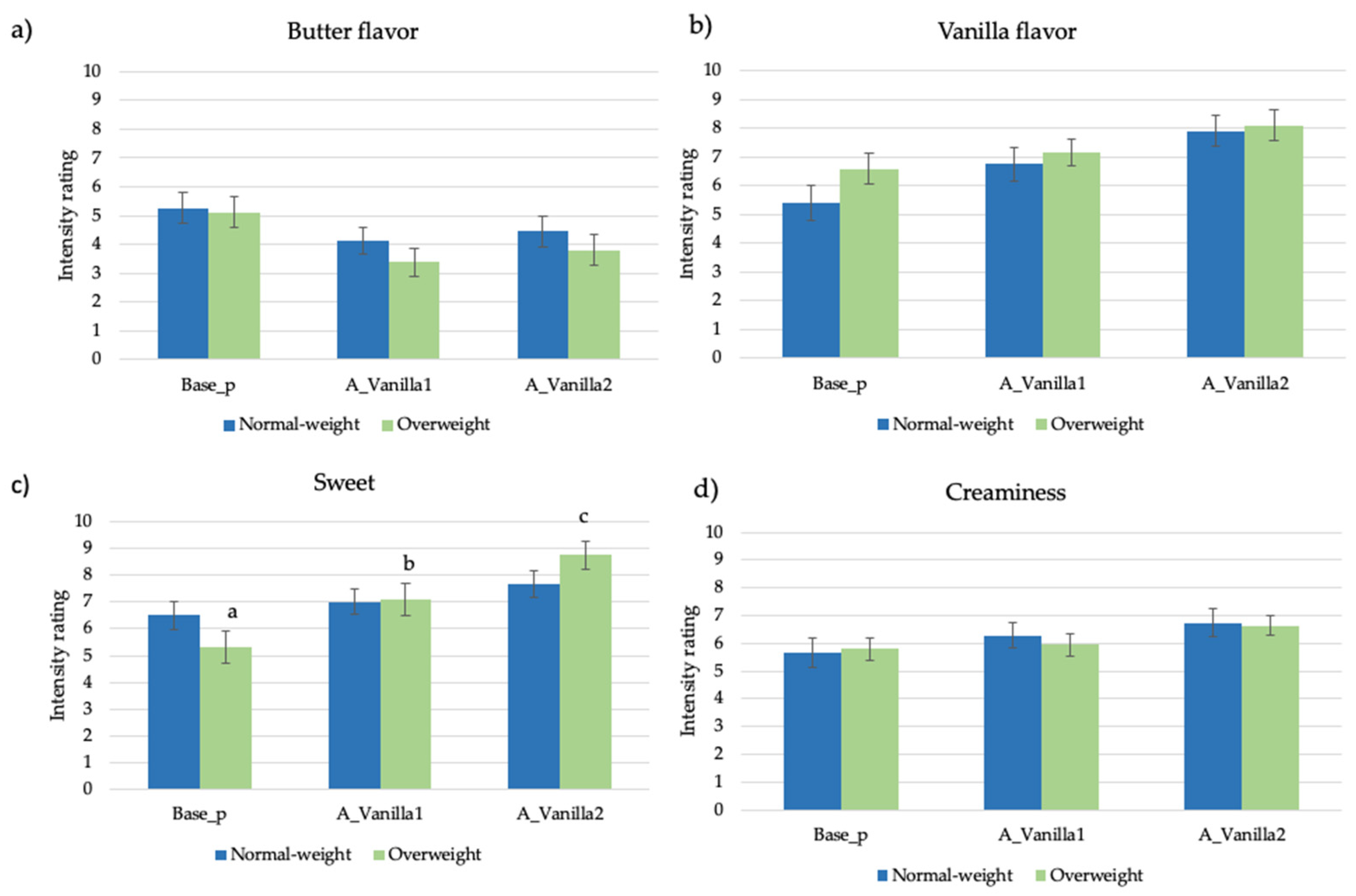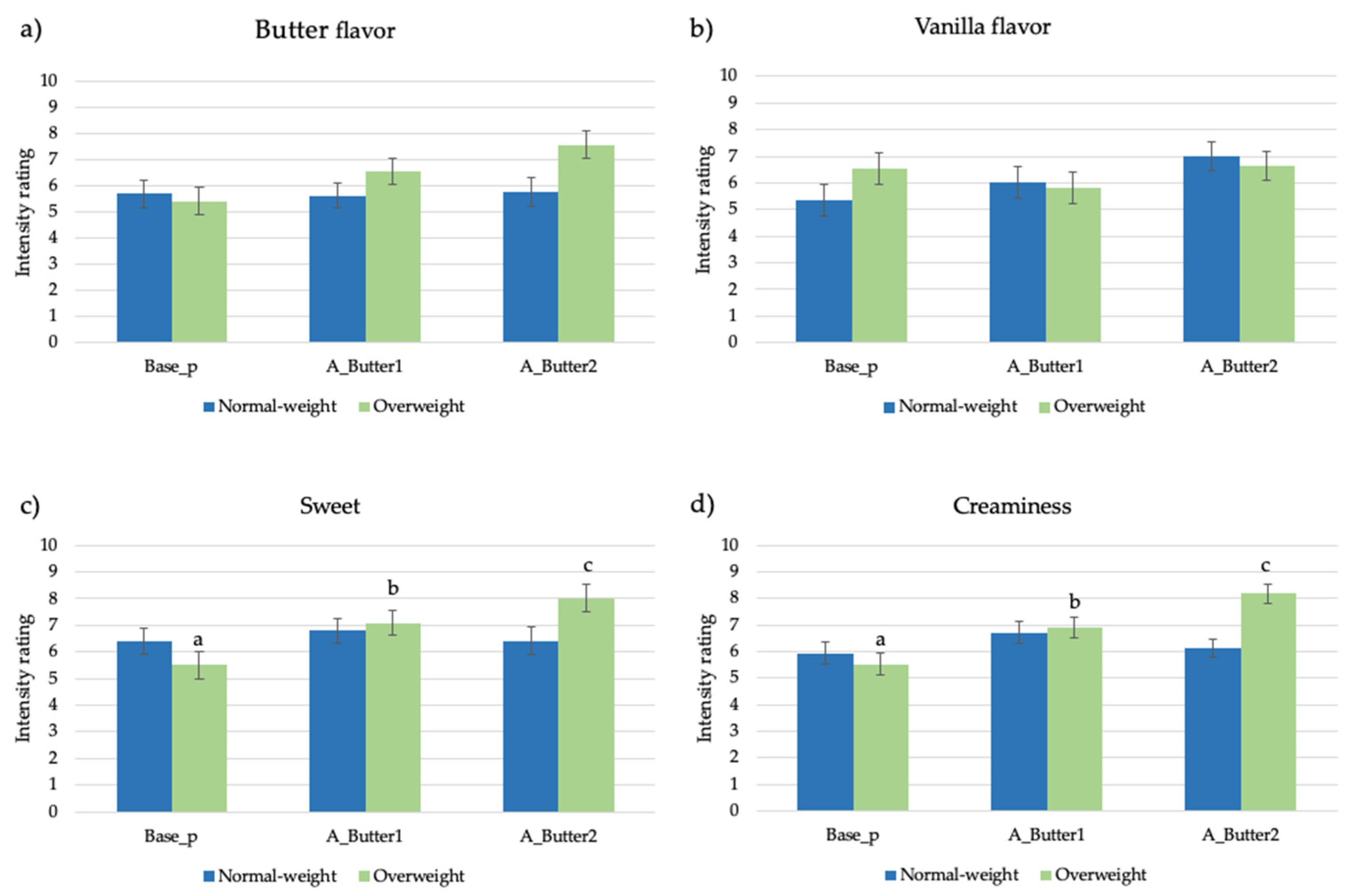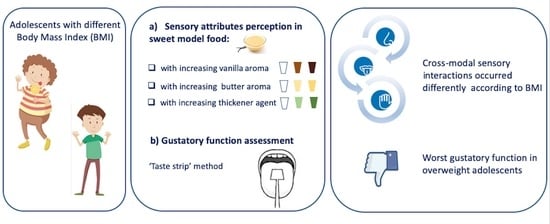Odor–Taste–Texture Interactions as a Promising Strategy to Tackle Adolescent Overweight
Abstract
:1. Introduction
2. Materials and Methods
2.1. Subjects
2.2. Samples Preparation
2.3. Gustatory Function Assessment
2.4. Overall Liking and Sensory Attributes Ratings Assessment
2.5. Experimental Design
2.6. Data Analysis
3. Results
3.1. Gustatory Function
3.2. Sensory Attributes Ratings
3.2.1. Samples Modified with Vanilla Aroma
3.2.2. Samples Modified with Butter Aroma
3.2.3. Samples Modified with Thickener Agent
3.3. Overall Liking
4. Discussion
5. Conclusions
Author Contributions
Funding
Institutional Review Board Statement
Informed Consent Statement
Acknowledgments
Conflicts of Interest
References
- Lowe, C.J.; Morton, J.B.; Reichelt, A.C. Adolescent obesity and dietary decision making—A brain-health perspective. Lancet Child Adolesc. Health 2020, 4, 388–396. [Google Scholar] [CrossRef]
- Reichelt, A.C. Adolescent maturational transitions in the prefrontal cortex and dopamine signaling as a risk factor for the development of obesity and high fat/high sugar diet induced cognitive deficits. Front. Behav. Neurosci. 2016, 10, 189. [Google Scholar] [CrossRef] [Green Version]
- Snoek, H.M.; Engels, R.C.; Van Strien, T.; Otten, R. Emotional, external and restrained eating behaviour and BMI trajectories in adolescence. Appetite 2013, 67, 81–87. [Google Scholar] [CrossRef] [PubMed]
- van Strien, T.; Cebolla, A.; Etchemendy, E.; Gutierrez-Maldonado, J.; Ferrer-Garcia, M.; Botella, C.; Baños, R. Emotional eating and food intake after sadness and joy. Appetite 2013, 66, 20–25. [Google Scholar] [CrossRef] [Green Version]
- Winpenny, E.M.; Penney, T.L.; Corder, K.; White, M.; van Sluijs, E.M. Change in diet in the period from adolescence to early adulthood: A systematic scoping review of longitudinal studies. Int. J. Behav. Nutr. Phys. Act. 2017, 14, 1–16. [Google Scholar] [CrossRef] [PubMed]
- Hu, F.B. Resolved: There is sufficient scientific evidence that decreasing sugar-sweetened beverage consumption will reduce the prevalence of obesity and obesity-related diseases. Obes. Rev. 2013, 14, 606–619. [Google Scholar] [CrossRef] [PubMed]
- Serafini, M.; Toti, E. Unsustainability of Obesity: Metabolic Food Waste. Front. Nutr. 2016, 3, 40. [Google Scholar] [CrossRef] [Green Version]
- DuBois, G.E.; Prakash, I. Non-caloric sweeteners, sweetness modulators, and sweetener enhancers. Annu. Rev. Food Sci. Technol. 2012, 3, 353–380. [Google Scholar] [CrossRef] [PubMed]
- Hutchings, S.C.; Low, J.Y.; Keast, R.S. Sugar reduction without compromising sensory perception. An impossible dream? Crit. Rev. Food Sci. Nutr. 2019, 59, 2287–2307. [Google Scholar] [CrossRef]
- Markey, O.; Lovegrove, J.A.; Methven, L. Sensory profiles and consumer acceptability of a range of sugar-reduced products on the UK market. Food Res. Int. 2015, 72, 133–139. [Google Scholar] [CrossRef]
- Stevenson, R.J.; Boakes, R.A.; Prescott, J. Changes in odor sweetness resulting from implicit learning of a simultaneous odor-sweetness association: An example of learned synesthesia. Learn. Motiv. 1998, 29, 113–132. [Google Scholar] [CrossRef]
- Boakes, R.A.; Hemberger, H. Odour-modulation of taste ratings by chefs. Food Qual. Prefer. 2012, 25, 81–86. [Google Scholar] [CrossRef]
- Alcaire, F.; Antúnez, L.; Vidal, L.; Giménez, A.; Ares, G. Aroma-related cross-modal interactions for sugar reduction in milk desserts: Influence on consumer perception. Food Res. Int. 2017, 97, 45–50. [Google Scholar] [CrossRef]
- Bertelsen, A.S.; Mielby, L.A.; Alexi, N.; Byrne, D.V.; Kidmose, U. Individual differences in sweetness ratings and cross-modal aroma-taste interactions. Foods 2020, 9, 146. [Google Scholar] [CrossRef] [Green Version]
- Velázquez, A.L.; Vidal, L.; Varela, P.; Ares, G. Cross-modal interactions as a strategy for sugar reduction in products targeted at children: Case study with vanilla milk desserts. Food Res. Int. 2020, 130, 108920. [Google Scholar] [CrossRef]
- McCrickerd, K.; Chambers, L.; Yeomans, M.R. Does modifying the thick texture and creamy flavour of a drink change portion size selection and intake? Appetite 2014, 73, 114–120. [Google Scholar] [CrossRef] [Green Version]
- Bolhuis, D.P.; Forde, C.G.; Cheng, Y.; Xu, H.; Martin, N.; de Graaf, C. Slow food: Sustained impact of harder foods on the reduction in energy intake over the course of the day. PLoS ONE 2014, 9, e93370. [Google Scholar] [CrossRef]
- De Wijk, R.A.; Zijlstra, N.; Mars, M.; De Graaf, C.; Prinz, J.F. The effects of food viscosity on bite size, bite effort and food intake. Physiol. Behav. 2008, 95, 527–532. [Google Scholar] [CrossRef] [PubMed]
- Forde, C.G.; Van Kuijk, N.; Thaler, T.; De Graaf, C.; Martin, N. Oral processing characteristics of solid savoury meal components, and relationship with food composition, sensory attributes and expected satiation. Appetite 2013, 60, 208–219. [Google Scholar] [CrossRef] [PubMed]
- Fogel, A.; Goh, A.T.; Fries, L.R.; Sadananthan, S.A.; Velan, S.S.; Michael, N.; Tint, M.-T.; Fortier, M.V.; Chan, M.J.; Toh, J.Y.; et al. Faster eating rates are associated with higher energy intakes during an ad libitum meal, higher BMI and greater adiposity among 4· 5-year-old children: Results from the Growing Up in Singapore Towards Healthy Outcomes (GUSTO) cohort. Br. J. Nutr. 2017, 117, 1042–1051. [Google Scholar] [CrossRef] [Green Version]
- Pangborn, R.M.; Szczesniak, A.S. Effect of hydrocolloids and viscosity on flavor and odor intensities of aromatic flavor compounds. J. Texture Stud. 1974, 4, 467–482. [Google Scholar] [CrossRef]
- Proserpio, C.; Laureati, M.; Bertoli, S.; Battezzati, A.; Pagliarini, E. Determinants of obesity in Italian adults: The role of taste sensitivity, food liking, and food neophobia. Chem. Senses 2016, 41, 169–176. [Google Scholar] [CrossRef] [Green Version]
- Hollowood, T.A.; Linforth RS, T.; Taylor, A.J. The effect of viscosity on the perception of flavour. Chem. Senses 2002, 27, 583–591. [Google Scholar] [CrossRef] [PubMed] [Green Version]
- Saint-Eve, A.; Kora, E.P.; Martin, N. Impact of the olfactory quality and chemical complexity of the flavouring agent on the texture of low fat stirred yogurts assessed by three different sensory methodologies. Food Qual Prefer. 2004, 15, 655–668. [Google Scholar] [CrossRef]
- Mameli, C.; Cattaneo, C.; Panelli, S.; Comandatore, F.; Sangiorgio, A.; Bedogni, G.; Bandi, C.; Zuccotti, G.; Pagliarini, E. Taste perception and oral microbiota are associated with obesity in children and adolescents. PLoS ONE 2019, 14, e0221656. [Google Scholar] [CrossRef]
- Soussignan, R.; Schaal, B.; Boulanger, V.; Gaillet, M.; Jiang, T. Orofacial reactivity to the sight and smell of food stimuli. Evidence for anticipatory liking related to food reward cues in overweight children. Appetite 2012, 58, 508–516. [Google Scholar] [CrossRef] [PubMed]
- Stafford, L.D.; Whittle, A. Obese individuals have higher preference and sensitivity to odor of chocolate. Chem. Senses 2015, 40, 279–284. [Google Scholar] [CrossRef]
- Proserpio, C.; Laureati, M.; Invitti, C.; Cattaneo, C.; Pagliarini, E. BMI and gender related differences in cross-modal interaction and liking of sensory stimuli. Food Qual. Prefer. 2017, 56, 49–54. [Google Scholar] [CrossRef]
- Proserpio, C.; Laureati, M.; Invitti, C.; Pasqualinotto, L.; Bergamaschi, V.; Pagliarini, E. Cross-modal interactions for custard desserts differ in obese and normal weight Italian women. Appetite 2016, 100, 203–209. [Google Scholar] [CrossRef]
- Herz, R.S.; Van Reen, E.; Gredvig-Ardito, C.A.; Carskadon, M.A. Insights into smell and taste sensitivity in normal weight and overweight-obese adolescents. Physiol. Behav. 2020, 221, 112897. [Google Scholar] [CrossRef] [PubMed]
- Landis, B.N.; Welge-Luessen, A.; Brämerson, A.; Bende, M.; Mueller, C.A.; Nordin, S.; Hummel, T. “Taste Strips”—A rapid, lateralized, gustatory bedside identification test based on impregnated filter papers. J. Neurol. 2009, 256, 242–248. [Google Scholar] [CrossRef] [PubMed] [Green Version]
- Mueller, C.; Kallert, S.; Renner, B.; Stiassny, K.; Temmel, A.F.; Hummel, T.; Kobal, G. Quantitative assessment of gustatory function in a clinical context using impregnated “taste strips”. Rhinology 2003, 41, 2–6. [Google Scholar] [PubMed]
- Overberg, J.; Hummel, T.; Krude, H.; Wiegand, S. Differences in taste sensitivity between obese and non-obese children and adolescents. Arch. Dis. Child. 2012, 97, 1048–1052. [Google Scholar] [CrossRef]
- Alexy, U.; Schaefer, A.; Sailer, O.; Bush-Stockfisch, M.; Huthmacher, S.; Kunert, J. Sensory preferences and discrimination ability of children in relation to their body weight status. J. Sens. Stud. 2011, 26, 409–412. [Google Scholar] [CrossRef]
- Pasquet, P.; Laure Frelut, M.; Simmen, B.; Marcel Hladik, C.; Monneuse, M.O. Taste perception in massively obese and in non-obese adolescents. Int. J. Pediatr. Obes. 2007, 2, 242–248. [Google Scholar] [CrossRef] [PubMed]
- Donaldson, L.F.; Bennett, L.; Baic, S.; Melichar, J.K. Taste and weight: Is there a link? Am. J. Clin. Nutr. 2009, 90, 800S–803S. [Google Scholar] [CrossRef] [PubMed] [Green Version]
- Simchen, U.; Koebnick, C.; Hoyer, S.; Issanchou, S.; Zunft, H.J. Odour and taste sensitivity is associated with body weight and extent of misreporting of body weight. Eur. J. Clin. Nutr. 2006, 60, 698–705. [Google Scholar] [CrossRef]
- Bartoshuk, L.M.; Duffy, V.B.; Hayes, J.E.; Moskowitz, H.R.; Snyder, D.J. Psychophysics of sweet and fat perception in obesity: Problems, solutions and new perspectives. Philos. Trans. R. Soc. Biol. Sci. 2006, 361, 1137–1148. [Google Scholar] [CrossRef] [Green Version]
- Grinker, J. Obesity and sweet taste. Am. J. Clin. Nutr. 1978, 31, 1078–1087. [Google Scholar] [CrossRef] [Green Version]
- Anderson, G.H. Sugars, sweetness, and food intake. Am. J. Clin. Nutr. 1995, 62, 195S–201S. [Google Scholar] [CrossRef]
- Salbe, A.D.; DelParigi, A.; Pratley, R.E.; Drewnowski, A.; Tataranni, P.A. Taste preferences and body weight changes in an obesity-prone population. Am. J. Clin. Nutr. 2004, 79, 372–378. [Google Scholar] [CrossRef]
- Frank, R.A.; Ducheny, K.; Mize, S.J. Strawberry odor, but not red color, enhances the sweetness of sucrose solutions. Chem. Senses 1989, 14, 371–377. [Google Scholar] [CrossRef]
- Green, B.G.; Nachtigal, D.; Hammond, S.; Lim, J. Enhancement of retronasal odors by taste. Chem. Senses 2012, 37, 77–86. [Google Scholar] [CrossRef] [PubMed] [Green Version]
- Herman, C.P.; Polivy, J. External cues in the control of food intake in humans: The sensory-normative distinction. Physiol. Behav. 2008, 94, 722–728. [Google Scholar] [CrossRef]
- Onaolapo, A.Y.; Onaolapo, O.J. Food additives, food and the concept of ‘food addiction’: Is stimulation of the brain reward circuit by food sufficient to trigger addiction? Pathophysiology 2018, 25, 263–276. [Google Scholar] [CrossRef] [PubMed]
- Gearhardt, A.N.; Corbin, W.R.; Brownell, K.D. Preliminary validation of the Yale food addiction scale. Appetite 2009, 52, 430–436. [Google Scholar] [CrossRef] [Green Version]
- Davis, C.; Carter, J.C. Compulsive overeating as an addiction disorder. A review of theory and evidence. Appetite 2009, 53, 1–8. [Google Scholar] [CrossRef]
- Volkow, N.D.; Wang, G.J.; Tomasi, D.; Baler, R.D. Obesity and addiction: Neurobiological overlaps. Obes. Rev. 2013, 14, 2–18. [Google Scholar] [CrossRef] [Green Version]
- Pretlow, R.A. Addiction to highly pleasurable food as a cause of the childhood obesity epidemic: A qualitative Internet study. Eat. Disord. 2011, 19, 295–307. [Google Scholar] [CrossRef] [Green Version]
- Nguyen, D.H.; Valentin, D.; Ly, M.H.; Chrea, C.; Sauvageot, F. When does smell enhance taste? Effect of culture and odorant/tastant relationship. In Proceedings of the European Chemoreception Research Organisation Conference, Erlangen, Germany, 23–27 July 2002; pp. 23–27. [Google Scholar]
- Yackinous, C.; Guinard, J.X. Flavor manipulation can enhance the impression of fat in some foods. J. Food Sci. 2000, 65, 909–914. [Google Scholar] [CrossRef]
- Weel, K.G.; Boelrijk, A.E.; Alting, A.C.; Van Mil, P.J.; Burger, J.J.; Gruppen, H.; Voragen, A.G.; Smit, G. Flavor release and perception of flavored whey protein gels: Perception is determined by texture rather than by release. J. Agric. Food Chem. 2002, 50, 5149–5155. [Google Scholar] [CrossRef]
- Carr, J.; Baloga, D.; Guinard, J.X.; Lawter, L.; Marty, C.; Cordelia, S. The Effect of Gelling Agent Type and Concen-Tration on Flavour Release in Model Systems; McGorrin, R.J., Leland, J.V., Eds.; American Chemical Society: Washington, DC, USA, 1996; pp. 98–108. [Google Scholar]



| Overweight (Mean ± SEM) | Normal-Weight (Mean ± SEM) | F | |
|---|---|---|---|
| Sweet Score | 2.96 ± 0.13 | 3.65 ± 0.15 | 11.66 *** |
| Bitter Score | 2.64 ± 0.20 | 3.30 ± 0.27 | 4.73 * |
| Salty Score | 2.60 ± 0.18 | 3.20 ± 0.20 | 5.18 * |
| Sour Score | 2.08 ± 0.14 | 2.85 ± 0.15 | 13.89 *** |
| Total Taste Score (TTS) | 10.28 ± 0.37 | 13.00 ± 0.42 | 23.40 *** |
| Samples | Liking Scores (Mean ± SEM) | F | ||
|---|---|---|---|---|
| Normal Weight | Overweight | |||
| Modified with vanilla aroma | 0.39 n.s | |||
| Base_p | 6.1 a ± 0.4 | 5.9 a ± 0.3 | ||
| A_Vanilla1 | 6.4 a ± 0.5 | 6.9 b ± 0.4 | ||
| A_Vanilla2 | 7.6 b ± 0.4 | 8.1 c ± 0.4 | ||
| Modified with butter aroma | 4.5 ** | |||
| Base_ p | 5.9 ± 0.4 | 5.8 a ± 0.3 | ||
| A_Butter1 | 6.6 ± 0.5 | 6.7 b ± 0.3 | ||
| A_Butter2 | 6.2 ± 0.4 | 8.5 c ± 0.4 | ||
| Modified with xanthan gum | ||||
| Base_ p | 6.1 ± 0.5 | 5.9 ± 0.4 | 0.08 n.s. | |
| T_Xanthan1 | 6.0 ± 0.5 | 5.7 ± 0.4 | ||
| T_Xanthan2 | 5.6 ± 0.4 | 5.7 ± 0.4 | ||
Publisher’s Note: MDPI stays neutral with regard to jurisdictional claims in published maps and institutional affiliations. |
© 2021 by the authors. Licensee MDPI, Basel, Switzerland. This article is an open access article distributed under the terms and conditions of the Creative Commons Attribution (CC BY) license (https://creativecommons.org/licenses/by/4.0/).
Share and Cite
Proserpio, C.; Verduci, E.; Zuccotti, G.; Pagliarini, E. Odor–Taste–Texture Interactions as a Promising Strategy to Tackle Adolescent Overweight. Nutrients 2021, 13, 3653. https://doi.org/10.3390/nu13103653
Proserpio C, Verduci E, Zuccotti G, Pagliarini E. Odor–Taste–Texture Interactions as a Promising Strategy to Tackle Adolescent Overweight. Nutrients. 2021; 13(10):3653. https://doi.org/10.3390/nu13103653
Chicago/Turabian StyleProserpio, Cristina, Elvira Verduci, Gianvincenzo Zuccotti, and Ella Pagliarini. 2021. "Odor–Taste–Texture Interactions as a Promising Strategy to Tackle Adolescent Overweight" Nutrients 13, no. 10: 3653. https://doi.org/10.3390/nu13103653
APA StyleProserpio, C., Verduci, E., Zuccotti, G., & Pagliarini, E. (2021). Odor–Taste–Texture Interactions as a Promising Strategy to Tackle Adolescent Overweight. Nutrients, 13(10), 3653. https://doi.org/10.3390/nu13103653










